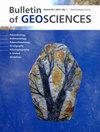The ichnospecies Tambia gregaria (Fritsch, 1908) comb. nov. from the Upper Ordovician of Czechia
IF 1.5
3区 地球科学
Q3 GEOSCIENCES, MULTIDISCIPLINARY
引用次数: 0
Abstract
reconstructions (e.g. Pemberton 1992, Pemberton et al. 2001, Buatois & Mángano 2011, Knaust & Bromley 2012) and for detecting evolutionary trends (e.g. Mángano & Buatois 2016a, b). Increased interest in ichnology resulted in the description and erection of numerous ichnotaxa that allowed for their recurrent recognition and communication. However, after the compilation of the second edition of the Trace Fossils volume in the Treatise of Invertebrate Paleontology (Häntzschel 1975), the number of valid invertebrate ichnogenera has multiplied (Knaust 2012, Buatois et al. 2017). Many ichnotaxa are based on weak grounds, either due to in appropriate characteristics chosen as ichnotaxobases, poor preservation, single specimens, or simply overlooked synonymy. Accordingly, comprehensive ichnotaxonomic reciews are necessary for the efficient and robust applic a tion of ichnologic evidence. This contribution provides a taxonomic assessment of the ichnospecies Curvolithus gregarius Fritsch, 1908 from the Upper Ordovician of Czechia (see Mikuláš 1992, for previous evaluations of this ichnofauna), based on a reinvestigation of the type material and newly col lected specimens. In a general review of the ichnogenus Curvolithus, Buatois et al. (1998) excluded the ichno species C. gregarius from that ichnogenus due to the morphological discrepancy with the diagnostic features of Curvolithus. These authors also noted similarities of the type material of C. gregarius with other scratched trace fossils supposedly produced by arthropods, such as Tam bia and Monomorphichnus. However, no formal ichno taxo n omic decision was made at that time, and the ichno taxon omic status of this ichno species was left indeterminate. Here, we formally include C. gregarius in Tambia Müller, 1969 as T. gregaria comb. nov. In addition, we briefly revise other ichnotaxa described by Fritsch (1908) that are related to T. gregaria. This study is part of an overall examination of historical tracefossil collections and ichnotaxonomic reevaluation of the collection of Fritsch (1908) at the National Museum in Prague, Czechia.鱼科植物塔比亚(Tambia gregaria, Fritsch, 1908)梳。11月来自捷克上奥陶统
重建(例如Pemberton 1992, Pemberton et al. 2001, Buatois & Mángano 2011, Knaust & Bromley 2012)以及检测进化趋势(例如Mángano & Buatois 2016a, b)。对技术的兴趣增加导致了许多鱼分类群的描述和建立,使它们能够反复识别和交流。然而,在《无脊椎动物古生物学专著》(Häntzschel 1975)中“微量化石”卷第二版的编纂之后,有效的无脊椎动物技术属的数量成倍增加(Knaust 2012, Buatois et al. 2017)。许多鱼分类群是建立在薄弱的基础上的,要么是由于选择了不适当的特征作为鱼分类基,要么是保存不良,要么是标本单一,要么是简单地忽视了同义。因此,全面的技术分类知识库是技术证据有效、可靠应用的必要条件。本文对捷克上奥陶统的Curvolithus gregarius Fritsch, 1908进行了分类评估(见Mikuláš 1992,对该鱼科动物的先前评价),基于对模式材料和新收集的标本的重新调查。Buatois et al.(1998)在对Curvolithus鱼属的综述中,由于与Curvolithus的诊断特征在形态上的差异,将该鱼属中的ichno - species C. gregarius排除在外。这些作者还注意到C. gregarius的类型材料与其他被认为是节肢动物(如Tam bia和Monomorphichnus)产生的划痕痕迹化石的相似性。然而,当时没有正式的鱼类分类组决定,该物种的鱼类分类组地位仍然不确定。在这里,我们正式将C. gregarius in Tambia mller, 1969作为T. gregaria comb。11 .此外,对Fritsch(1908)所描述的与T. gregaria有亲缘关系的其他ichnotaxa进行了简要的修正。这项研究是对捷克布拉格国家博物馆的历史化石收藏和弗里奇(1908)收藏的技术分类重新评估的整体检查的一部分。
本文章由计算机程序翻译,如有差异,请以英文原文为准。
求助全文
约1分钟内获得全文
求助全文
来源期刊

Bulletin of Geosciences
地学-地球科学综合
CiteScore
3.10
自引率
5.30%
发文量
18
审稿时长
>12 weeks
期刊介绍:
The Bulletin of Geosciences is an international journal publishing original research papers, review articles, and short contributions concerning palaeoenvironmental geology, including palaeontology, stratigraphy, sedimentology, palaeogeography, palaeoecology, palaeoclimatology, geochemistry, mineralogy, geophysics, and related fields. All papers are subject to international peer review, and acceptance is based on quality alone.
 求助内容:
求助内容: 应助结果提醒方式:
应助结果提醒方式:


